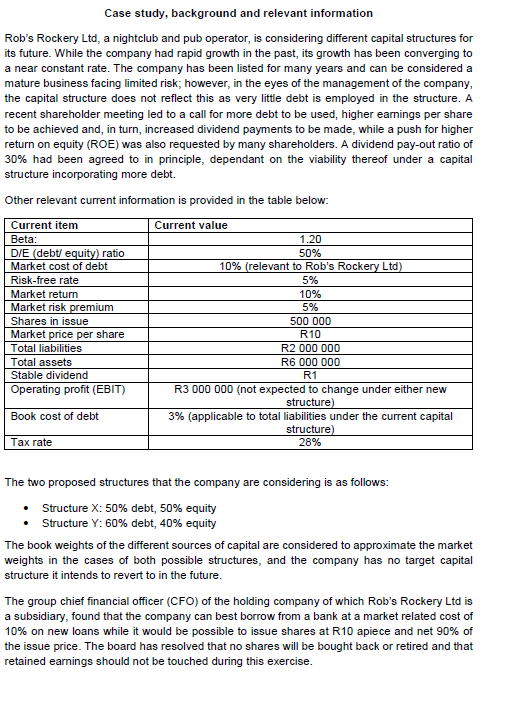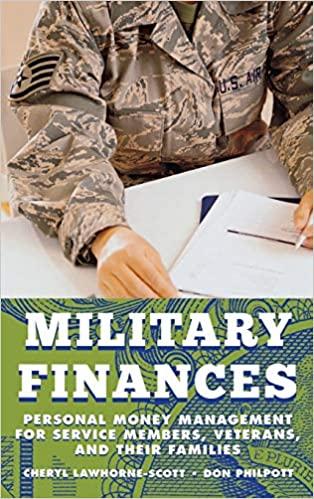See attached.


Case study, background and relevant information Rob's Rockery Ltd, a nightclub and pub operator, is considering different capital structures for its future. While the company had rapid growth in the past, its growth has been converging to a near constant rate. The company has been listed for many years and can be considered a mature business facing limited risk; however, in the eyes of the management of the company, the capital structure does not reflect this as very little debt is employed in the structure. A recent shareholder meeting led to a call for more debt to be used, higher earnings per share to be achieved and, in turn, increased dividend payments to be made, while a push for higher return on equity (ROE) was also requested by many shareholders. A dividend pay-out ratio of 30% had been agreed to in principle, dependant on the viability thereof under a capital structure incorporating more debt. Other relevant current information is provided in the table below: Current item Current value Beta: 1.20 D/E (debt/ equity) ratio 50% Market cost of debt 10% (relevant to Rob's Rockery Ltd) Risk-free rate 5% Market return 10% Market risk premium 5% Shares in issue 500 000 Market price per share R10 Total liabilities R2 000 000 Total assets R6 000 000 Stable dividend R1 Operating profit (EBIT) R3 000 000 (not expected to change under either new structure) Book cost of debt 3% (applicable to total liabilities under the current capital structure) Tax rate 28% The two proposed structures that the company are considering is as follows: Structure X: 50% debt, 50% equity Structure Y: 60% debt, 40% equity The book weights of the different sources of capital are considered to approximate the market weights in the cases of both possible structures, and the company has no target capital structure it intends to revert to in the future. The group chief financial Officer (CFO) of the holding company of which Rob's Rockery Ltd is a subsidiary, found that the company can best borrow from a bank at a market related cost of 10% on new loans while it would be possible to issue shares at R10 apiece and net 90% of the issue price. The board has resolved that no shares will be bought back or retired and that retained earnings should not be touched during this exercise. Required The group CFO has tasked you, the financial manager of Rob's Rockery Ltd, with tabling different sources of financing the company can use. She has already proposed proportions of capital based on her extensive experience in the field and industry. She has tasked you with evaluating the two options that will go to the board. Both capital structures are considered to be plausible and have benefits and drawbacks; therefore, the group CFO tasked you with evaluating the two possible structures as set out below: The report should be structured as follows (with the expected calculations to base your discussions on indicated in brackets): A. Cost (weighted average cost of capital) B. Risk (debt ratio, times interest earned or interest coverage ratio) C. Profitability (ROE, EPS) D. Dividend payment feasibility (dividends per share) E. Financial flexibility of each structure F. Arguments for and against each structure (9 marks) (5 marks) (5 marks) (4 marks) (2 marks) (5 marks) Number your calculations and discussions as per the structure above. (Hint: use Hamada's equation when adjusting beta for risk.) Case study, background and relevant information Rob's Rockery Ltd, a nightclub and pub operator, is considering different capital structures for its future. While the company had rapid growth in the past, its growth has been converging to a near constant rate. The company has been listed for many years and can be considered a mature business facing limited risk; however, in the eyes of the management of the company, the capital structure does not reflect this as very little debt is employed in the structure. A recent shareholder meeting led to a call for more debt to be used, higher earnings per share to be achieved and, in turn, increased dividend payments to be made, while a push for higher return on equity (ROE) was also requested by many shareholders. A dividend pay-out ratio of 30% had been agreed to in principle, dependant on the viability thereof under a capital structure incorporating more debt. Other relevant current information is provided in the table below: Current item Current value Beta: 1.20 D/E (debt/ equity) ratio 50% Market cost of debt 10% (relevant to Rob's Rockery Ltd) Risk-free rate 5% Market return 10% Market risk premium 5% Shares in issue 500 000 Market price per share R10 Total liabilities R2 000 000 Total assets R6 000 000 Stable dividend R1 Operating profit (EBIT) R3 000 000 (not expected to change under either new structure) Book cost of debt 3% (applicable to total liabilities under the current capital structure) Tax rate 28% The two proposed structures that the company are considering is as follows: Structure X: 50% debt, 50% equity Structure Y: 60% debt, 40% equity The book weights of the different sources of capital are considered to approximate the market weights in the cases of both possible structures, and the company has no target capital structure it intends to revert to in the future. The group chief financial Officer (CFO) of the holding company of which Rob's Rockery Ltd is a subsidiary, found that the company can best borrow from a bank at a market related cost of 10% on new loans while it would be possible to issue shares at R10 apiece and net 90% of the issue price. The board has resolved that no shares will be bought back or retired and that retained earnings should not be touched during this exercise. Required The group CFO has tasked you, the financial manager of Rob's Rockery Ltd, with tabling different sources of financing the company can use. She has already proposed proportions of capital based on her extensive experience in the field and industry. She has tasked you with evaluating the two options that will go to the board. Both capital structures are considered to be plausible and have benefits and drawbacks; therefore, the group CFO tasked you with evaluating the two possible structures as set out below: The report should be structured as follows (with the expected calculations to base your discussions on indicated in brackets): A. Cost (weighted average cost of capital) B. Risk (debt ratio, times interest earned or interest coverage ratio) C. Profitability (ROE, EPS) D. Dividend payment feasibility (dividends per share) E. Financial flexibility of each structure F. Arguments for and against each structure (9 marks) (5 marks) (5 marks) (4 marks) (2 marks) (5 marks) Number your calculations and discussions as per the structure above. (Hint: use Hamada's equation when adjusting beta for risk.)








